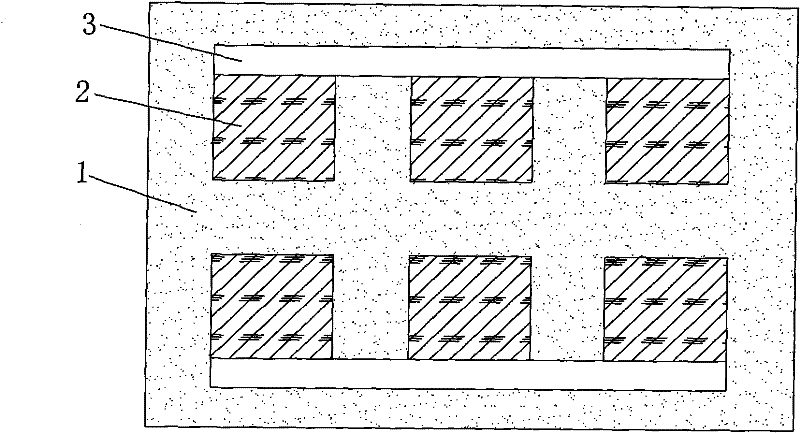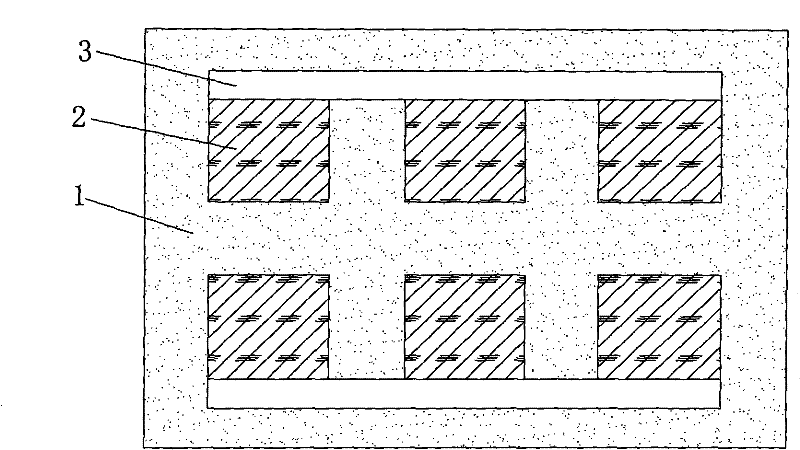Long-term governance method for converting saline-alkali soil into fertile farmland
A saline-alkali land and saline-alkali technology, which is applied in the direction of soil preparation, restoration of polluted soil, agricultural machinery and implements, etc., can solve the problems of soil alkalinity reduction, failure to maintain for a long time, and can not be maintained for a long time, so as to improve soil quality, effective and long-term Governance effect, good permeability effect
- Summary
- Abstract
- Description
- Claims
- Application Information
AI Technical Summary
Problems solved by technology
Method used
Image
Examples
Embodiment 1
[0022] The treatment method of turning saline-alkali land into good land described in this embodiment is applicable to the transformation of light saline-alkali land and moderate saline-alkali land with a groundwater level deeper than 115 cm and an area of saline-alkali land greater than 5 mu, such as figure 1 and figure 2 As shown, the specific method is:
[0023] (1) several deep pits 2 with a depth of 1.15m are dug out by machinery in the saline-alkali land 1 (see figure 1 ), the distance between the deep pits is 6m, and the land area occupied by all the deep pits is 55%-70% of the whole saline-alkali land 1 area. Place the 30cm-thick mellow soil excavated from the surface down, and place the excavated 85cm-thick raw soil together.
[0024] (2) Lay the alkali discharge filler layer 5 at the bottom of the deep pit 2 that has been dug (see figure 2 ), laying thickness first is the lower packing 6 of 20cm, and the lower packing 6 comprises the concrete body and the coal...
Embodiment 2
[0031] The treatment method of turning saline-alkali land into good fields described in this embodiment is suitable for the transformation of heavy saline-alkali land with a groundwater level deeper than 105 cm and an area of saline-alkali land greater than 5 mu. The specific methods are:
[0032] (1) First remove the salinized topsoil layer of 5 cm on the surface of the saline-alkali land, and then dig out deep pits with a depth of 1 m by machinery. %. Place the 30cm-thick mellow soil excavated from the surface down, and place the excavated 70cm-thick raw soil together.
[0033] (2) Lay a saline-alkali discharge filler layer at the bottom of the dug deep pit 2 . Lay the lower layer of filler with a thickness of 20cm. The lower layer of filler includes concrete with a particle size of 8cm and coal gangue; on the lower layer of filler, lay a middle layer of filler with a thickness of 15cm. The middle layer of filler includes stones, coal gangue, broken bricks and tiles and c...
Embodiment 3
[0040] The treatment method for transforming saline-alkali land into good land described in this example is applicable to the transformation of light saline-alkali land and moderate saline-alkali land with a groundwater level deeper than 120 cm and an area of saline-alkali land less than or equal to 5 mu. The specific methods are:
[0041] (1) Excavate the entire saline-alkali land into a deep pit with a depth of 1.2m by machinery, place the mellow soil with a thickness of 30cm below the dug surface layer, and place the raw soil with a thickness of 90cm below the mellow soil layer.
[0042] (2) at the bottom of the well-dug deep pit, first lay the lower layer of filler with a thickness of 30cm, and the lower layer of filler includes a concrete body and coal gangue with a particle diameter of 8cm; on the lower layer that has been paved, another layer of thickness is 10cm The upper layer of filler, The upper layer of fill includes stones and broken bricks and tiles with a parti...
PUM
 Login to View More
Login to View More Abstract
Description
Claims
Application Information
 Login to View More
Login to View More - R&D
- Intellectual Property
- Life Sciences
- Materials
- Tech Scout
- Unparalleled Data Quality
- Higher Quality Content
- 60% Fewer Hallucinations
Browse by: Latest US Patents, China's latest patents, Technical Efficacy Thesaurus, Application Domain, Technology Topic, Popular Technical Reports.
© 2025 PatSnap. All rights reserved.Legal|Privacy policy|Modern Slavery Act Transparency Statement|Sitemap|About US| Contact US: help@patsnap.com



